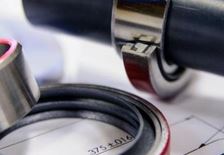
Many breakthroughs in technology have aided the evolution from braided packing to advanced mechanical seals, leading to remarkable gains in pump performance, efficiency and safety. Although mechanical seals are certainly a fitting solution for an array of pump and rotary applications, advances in polytetrafluoroethylene (PTFE) rotary lip seals can also solve these challenging radial sealing solutions.
Radial lip seals can retain lubricants and excluded unwanted contaminants for a fraction of the cost of a mechanical seal, while providing many of the same benefits in terms of performance and seal life.
PTFE Rotary Lip Seals vs. Mechanical Seals
For the purposes of this piece, we’ll use PTFE to describe a range of specific material variants, from virgin PTFE to various alternatives based on additional “filled” supplements that can have dramatic effects on durability, chemical compatibility, and performance.
Advances in radial lip seal technology have focused on the evolution from elastomeric spring loaded lip seals to thermoplastic materials with innovative lip designs for both inclusion and exclusionary sealing requirements.
Glass and bronze fillers give PTFE greater strength for higher pressure conditions. The pressure, temperature and chemical compatibility of contemporary PTFE lip seals perform satisfactorily across a range of rotary applications, and at a much lower cost than their mechanical seal counterparts.
These rotary shaft seals perform exceedingly well with stick-slip and running friction. In addition, the PTFE’s material memory allows for necessary radial loading on the shaft, which allows profiles to seal without a spring. PTFE operates effectively between -200 and +400 Fahrenheit ( -129 to +204 Celsius). Slight improvements to the higher temperature limits can be achieved with modified compounds containing specialized fillers.
Configurations of Rotary Lips Seals
PTFE rotary lip seals are produced in three configurations, all of which can be manufactured to standard inch and metric gland geometries:
- Non-encased lop seal, which employ an elastomer o-ring on the perimeter. These seals have the least tolerance for pressure and surface speed, up to 150 pounds per square inch (psi) and 6,000 surface feet per minute (sfpm) respectively. But compared to their elastomeric counterparts, these seals solve many problems related to chemical compatibility, high and low temperature and custom lip geometry. A number of standard lip geometries can optimize both inclusionary and exclusionary requirements. In addition to these profiles, any number of custom variations can be machined due to the versatile, efficient manufacturing process.
- Metal encased, or canned, PTFE radial lip seals should be considered for pressure limits from 150 to 500 psi and surface speed limits of 6,000 to 10,000 sfpm. Placing a gasket between the “can” and sealing lips will avoid potential leak paths. The gasket materials are the same as the retention o-ring for non-encased radial lip seals. Metal case materials include aluminum, stainless steel and cold-rolled steel.
- Machine flanged u-cup seals feature a metallic spring, and provide greater pressure resistance (up to 10,000 psi) but have limits to their surface speed range (1,000 sfpm). Bore retention is accomplished with a flange design that can be clamped axially into the gland to make sure the seal does not rotate. Three types of springs, each with different load and deflection characteristics, are available for u-cup seals: cantilever springs, canted-coil springs and helical springs. Due to the spring’s defection range affecting the seal’s ability to compensate for variations in gland tolerances and normal seal wear, springs with a wide deflection should be used when sealing surfaces are non-concentric.
Hardware Considerations
It’s important to understand any hardware-related issues before 
Surface finish level requirements are specific to the media being sealed and should be discussed with a seal application engineer. For lower pressure applications, a press fit is typically sufficient to obtain adequate bore plate.
Material Housing
Take care when using softer materials such as bronze, aluminum or plastic for housing. Aluminum’s thermal expansion rate is nearly double that of steel. Metal case designs can lose the required press fit in an aluminum housing when subjected to thermal cycling.
To align the seal during installation and prevent it from moving, use a lead-in chamfer for all seal housings. Both corners of the chamfer should be free of burrs and sharp edges.
Pressure Limits
For pressurized applications, take extra measures to ensure the seal is not pushed from the housing. Add a snap ring or cover plate to the seal if it is installed in an open bore.
As a rule, retention devices should be used with non-encased lip seals over 2 psi and 30 psi for metal encased seals. Lastly, spring loaded u-shaped seals with a flange can be clamped into the housing using a two-piece hardware configuration for seal containment.
Proper Alignment
Shaft misalignment can cause eccentricity and run-out. Eccentricity forces the seal lip to follow a shaft that is not centered in the bore, wearing the lip more on one side. Because PTFE seals are less elastic, they are more susceptible to failure from misalignment and run-out conditions than elastomeric lip seals. Eccentricity also enlarges the extrusion gap on one side, which could be detrimental when high pressure is involved. Prevent this with extended heal design to reduce seal extrusion.
Shaft run-out is a term for what happens when the shaft spins on axis of rotation that is offset from the geometric center of the shaft. Run-out can be caused by a bent shaft or by whirling deflection when spinning. The problem is that the seal must be compliant enough to maintain contact with the shaft despite being compressed and extended with each revolution.
Designed for Success
In the end, the success of a pump application depends on qualifying the proper seal configuration and conducting thorough tests. It is tempting to blame a failed seal for a leaking pump or fluid movement system. But leakage control is influenced by more than just a seal and can be compromised by deviating from recommended installation protocol and hardware guidance.
Too often, pump designers approach seals with a one-size-fits-all mentality, or assume past solutions are their best options.
Such thinking ignores the range of innovation in modern sealing choices. Choosing the right seal means identifying critical application details and choosing the best fit from an ever-evolving list of sealing solutions.
